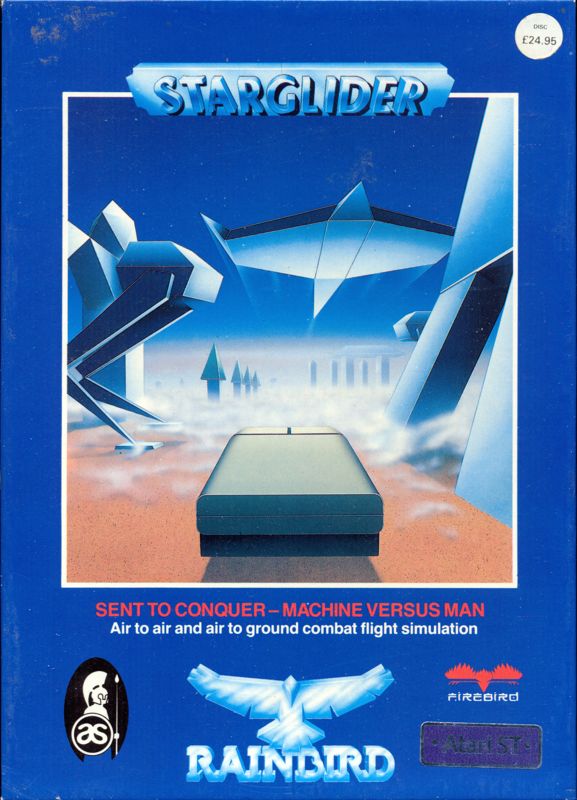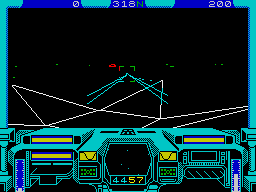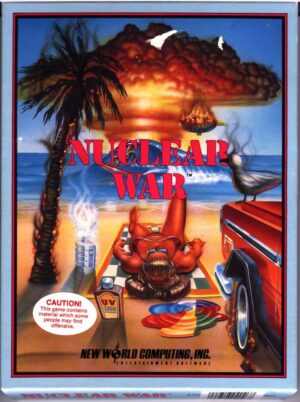Retro Replay Review
Gameplay
Starglider throws you into the cockpit of the Airborne Ground Attack Vehicle (AGAV) with almost no hand-holding, challenging you to fend off the Egron invasion through pure skill and strategy. Your controls span throttle management, missile targeting and firing, shield recharges, and an in-cockpit scanner that feels genuinely indispensable. Between the high-speed dogfights and tactical retreats to repair depots, the game sustains a tense rhythm that keeps you on the edge of your seat.
(HEY YOU!! We hope you enjoy! We try not to run ads. So basically, this is a very expensive hobby running this site. Please consider joining us for updates, forums, and more. Network w/ us to make some cash or friends while retro gaming, and you can win some free retro games for posting. Okay, carry on 👍)
The inclusion of fixed or floating sighting modes allows for personalized playstyles. Beginners can opt for automatic centering to simplify target locks, while veteran pilots can push the limits of manual aiming to hit long-range shots with pinpoint accuracy. This balance between accessibility and depth is rare in titles of this era, and it gives Starglider a remarkably flexible learning curve that rewards practice and perseverance.
Resource management is equally critical. With only two homing missiles at launch and each Egron Starglider requiring three missiles to down, you’ll need to plot strategic stops at repair depots to restock and repair damage. This creates a constant tension: do you press forward to engage more enemies on one missile, or do you play it safe and risk giving your foes time to swarm?
Progression comes in discrete levels, each escalating in speed, enemy aggressiveness and environmental hazards. Even once you master the basics, later stages introduce fast-moving Egron strike squadrons and tighter navigation corridors that demand split-second reactions. The learning curve never feels unfair, though—it’s simply a matter of honing your reflexes, familiarizing yourself with the 10,000-sector map and squeezing every ounce of performance from the AGAV.
Graphics
Starglider’s graphics may look simplistic by modern standards, but they deliver a pioneering sense of three-dimensional space unmatched by many contemporaries. The game uses smooth wireframe models and solid polygon fills to portray both your cockpit and the alien Starglider craft. When you weave through enemy fire and rack up kills, the minimalist aesthetic actually enhances focus rather than distracting you with over-the-top visual effects.
Inside the cockpit, the heads-up display (HUD) is clean, informative and responsive. Your shield strength, missile count, radar scanner and speedometer are all easily legible against the backdrop of deep space. This clarity is crucial when you’re juggling multiple systems under fire, and it stands as a testament to the designers’ focus on function over flash.
Environmental details—distant asteroid fields, planetary horizons and space debris—are rendered with subtle shading cues that reinforce the feeling of altitude and depth. The occasional burst of plasma trails behind enemy craft, and explosions are signified by quick polygon expansions. These effects might seem modest today, but in Starglider they created genuine impressions of scale and danger.
Performance is rock-solid even during the most frenetic sequences. Frame rates remain consistent, input latency is minimal and the AGAV’s controls feel weighty without ever becoming sluggish. Whether you’re strafing ground targets or dogfighting in open space, Starglider maintains a smooth visual flow that supports its breakneck gameplay tempo.
Story
The narrative premise in Starglider is simple but effective: the peaceful planet Novenia has fallen victim to a cunning Egron attack force, disguised as the harmless Starglider species. This subterfuge allowed them to bypass automated defenses and threaten the entire planet, setting the stage for a desperate last line of defense—you and your AGAV.
What the story lacks in elaborate cutscenes or branching dialogue, it makes up for in pure immersion. From the moment you take the cockpit, mission briefings emphasize the stakes: every Egron vessel you fail to destroy brings Novenia closer to collapse. Though the dialogue is minimal, each level’s briefing builds tension, and the sparse radio chatter during combat amplifies the sense of isolation and urgency.
The conceit of fighting an invader that mimics your own species adds an intriguing twist. The idea that your automated defenses will not fire on Starggliders raises the narrative stakes—you must deliver the shots your turrets cannot. This tension between recognition and threat is woven into every corner of the game’s premise.
While there’s little character development or subplot, the straightforward “one‐pilot‐versus‐legion” arc underscores a classic sci-fi theme: the lone hero standing firm against overwhelming odds. For players seeking a strong thematic backdrop to their combat, Starglider’s lean storyline hits the right notes without ever overstaying its welcome.
Overall Experience
Starglider remains a standout title for anyone interested in classic space combat simulations. Its combination of tight controls, challenging enemy AI and minimalist yet functional presentation yields an adrenaline-fueled ride that feels both fresh and timeless. Whether you’re blasting Egron Stargliders in open space or executing precision runs on ground installations, the game never loses its sense of momentum.
Replay value is high due to the game’s steep difficulty curve and the satisfaction of shaving seconds off your mission times. Each level demands mastery of different tactics—from conserving missiles on early waves to managing burst speed and shield recharges in later, deadly skirmishes. Even after you’ve completed the main campaign, you’ll find yourself dipping back in to perfect your performance.
Though the graphics and sound design are minimal by today’s metrics, they contribute to an immersive “you-are-there” sensation. There are no superfluous cutscenes or trophy unlocks—just raw, unfiltered space combat. This purity of design means Starglider excels at what it sets out to do: deliver a focused, high-octane battle experience.
In sum, Starglider is a must-play for aficionados of retro simulations and anyone seeking explosive action wrapped in a lean, efficient package. Its straightforward storyline, robust cockpit controls and demanding gameplay combine into an experience that still resonates decades after its initial release. If you’re looking for a game that prioritizes skillful play, resource management and relentless tension, Starglider is ready to pilot you into the fray.
 Retro Replay Retro Replay gaming reviews, news, emulation, geek stuff and more!
Retro Replay Retro Replay gaming reviews, news, emulation, geek stuff and more!









Reviews
There are no reviews yet.